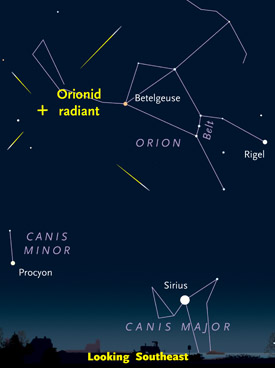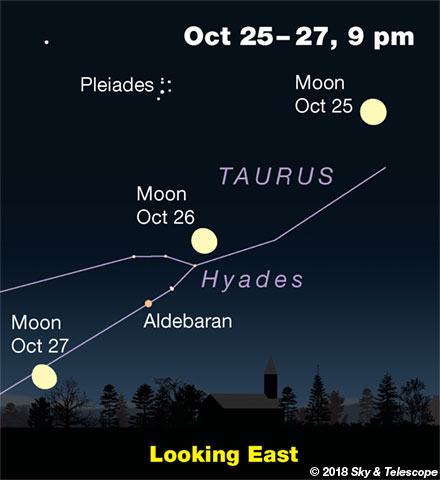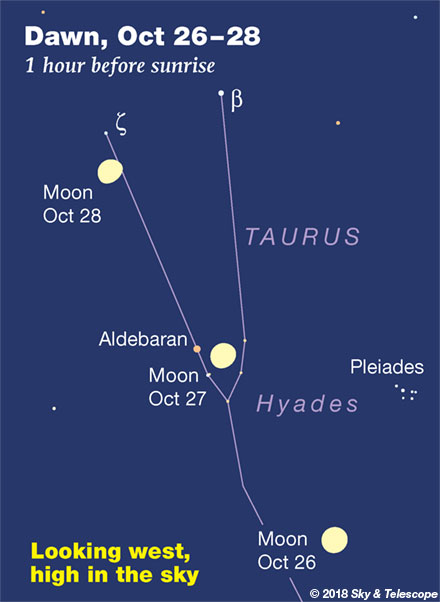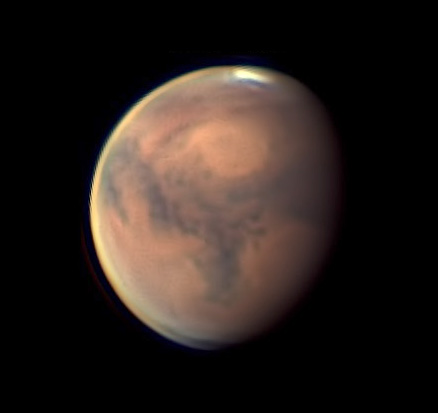Friday, October 19
• The waxing gibbous Moon at dusk forms a right triangle (as seen from North America) with Mars to its right and Fomalhaut below it. Later in the evening, the triangle turns clockwise as it wheels across the southern sky.

• The medium-weak Orionid meteor shower should be active in the early-morning hours for the next few nights. Tonight you have a dark window of about three hours between moonset and the beginning of dawn. Each morning after that, the Moon sets about an hour later. In a really dark sky you might count a dozen Orionids per hour. Through light pollution, you'll see fewer.
Saturday, October 20
• After dark, look upper left of the Moon by two or three fists at arm's length for the Great Square of Pegasus. It's standing on one corner, and it's a little more than a fist at arm's length in size.
• Tonight is International Observe the Moon Night, and at least 752 public observing events are planned worldwide! Click the link to find the ones near you.
Or if you're staying home, Gianluca Masi of the Virtual Telescope Project offers live online Moon views and programming from Italy starting at 16:00 UT (noon Eastern Daylight Time).
• Algol is at its minimum light, magnitude 3.4 instead of its usual 2.1, for a couple hours centered on 10:39 p.m. EDT. Algol takes several additional hours to fade and to rebrighten.
Sunday, October 21
• Around the very end of twilight, you'll find zero-magnitude Arcturus shining low in the west-northwest at the same height as zero-magnitude Capella in the northeast.
When this happens, turn to the south-southeast, and there will be 1st-magnitude Fomalhaut at the same height too — if you're at latitude 43° north. Seen from south of that latitude Fomalhaut will appear higher; from north of there it will be lower.
That bright point far upper right of Fomalhaut is Mars.
Monday, October 22
• Draw a line from Altair, the brightest star very high in the southwest after dark, to the right through Vega, very high in the west and even brighter. Continue the line half as far onward and you hit the Lozenge: the pointy-nosed head of Draco, the Dragon. Its brightest star is orange Eltanin, the tip of the Dragon's nose, always pointing toward Vega.


Tuesday, October 23
The Ghost of Summer Suns. Halloween is approaching, and this means that Arcturus, the star sparkling low in the west-northwest in twilight, is taking on its role as "the Ghost of Summer Suns." What does this mean? For several days centered on October 25th every year, Arcturus occupies a special place above your local landscape. It closely marks the spot where the Sun stood at the same time, by the clock, during hot June and July — in broad daylight, of course! So, as Halloween approaches every year, you can see Arcturus as the forlorn, chilly ghost of the departed summer Sun.
Wednesday, October 24
• Full Moon (exact at 12:45 p.m. EDT). This evening look upper left of it, by one or two fists at arm's length, for the two brightest stars of Aries lined up nearly horizontally.
And look left of the Moon by two or three fists for the little Pleiades cluster on the rise. Whenever we see the Pleiades climbing the eastern sky, their tiny dipper shape is standing on its handle.
Thursday, October 25
• Now the Pleiades are hardly more that a fist to the left of the Moon. Below the Pleiades by a similar distance is orange Aldebaran.
Friday, October 26
• The waning gibbous Moon is well up in the east by late evening, with the Pleiades above it and Aldebaran closer to its lower left (for North America).
Saturday, October 27
• A small telescope will show Saturn's largest moon, Titan, about four ring-lengths to Saturn's west this evening.
• The dog-bone-shaped asteroid 216 Kleopatra, with its two tiny moons, should occult an 11th-magnitude star in Canis Minor during Sunday's early-morning hours along a path from central Alberta through upstate New York and Long Island. Details, map, finder charts.
________________________
Want to become a better astronomer? Learn your way around the constellations! They're the key to locating everything fainter and deeper to hunt with binoculars or a telescope.
This is an outdoor nature hobby. For an easy-to-use constellation guide covering the whole evening sky, use the big monthly map in the center of each issue of Sky & Telescope, the essential guide to astronomy.

Once you get a telescope, to put it to good use you'll need a detailed, large-scale sky atlas (set of charts). The basic standard is the Pocket Sky Atlas (in either the original or Jumbo Edition), which shows stars to magnitude 7.6.
Next up is the larger and deeper Sky Atlas 2000.0, plotting stars to magnitude 8.5; nearly three times as many. The next up, once you know your way around, are the even larger Interstellarum atlas (stars to magnitude 9.5) and Uranometria 2000.0 (stars to magnitude 9.75). And read how to use sky charts with a telescope.
You'll also want a good deep-sky guidebook, such as Sue French's Deep-Sky Wonders collection (which includes its own charts), Sky Atlas 2000.0 Companion by Strong and Sinnott, or the bigger Night Sky Observer's Guide by Kepple and Sanner.
Can a computerized telescope replace charts? Not for beginners, I don't think, and not on mounts and tripods that are less than top-quality mechanically (meaning heavy and expensive). And as Terence Dickinson and Alan Dyer say in their Backyard Astronomer's Guide, "A full appreciation of the universe cannot come without developing the skills to find things in the sky and understanding how the sky works. This knowledge comes only by spending time under the stars with star maps in hand."
This Week's Planet Roundup

Venus is hidden in the glare of the Sun.
Mars (magnitude –0.8) shines highest in the south soon after dark. It sets around 1 a.m.
In a telescope Mars shrinks from 13 to 12 arcseconds wide this week, and it's as gibbous as we ever see it: 86 percent sunlit. For a Mars map that displays which side is facing Earth at your time and date, use our Mars Profiler.
Jupiter (magnitude –1.8) is very low in the west-southwest in early twilight and sets before twilight's end. Can you still make out fainter orange Antares, magnitude +1.0, about 14° to Jupiter's left?
Saturn (magnitude +0.5, upper right of the Sagittarius Teapot) glows yellow in the south-southwest in late dusk. It's midway between Mars and Jupiter.
Uranus, near the Aries-Pisces border, is easy in binoculars at magnitude 5.7 — with a good finder chart, if you know the constellations well enough to see where to start with the chart.
Neptune, in Aquarius, is harder at magnitude 7.8. By mid-evening they're well up in the east and southeast, respectively. Finder charts for Uranus and Neptune, or see the September Sky & Telescope, page 48.
______________________
All descriptions that relate to your horizon — including the words up, down, right, and left — are written for the world's mid-northern latitudes. Descriptions that also depend on longitude (mainly Moon positions) are for North America.
Eastern Daylight Time (EDT) is Universal Time (also called UT, UTC, GMT, or Z time) minus 4 hours.
______________________
"Rational and innocent entertainment of the highest kind."
— John Mills, 19th century Scottish manufacturer and founder of Mills Observatory, on amateur astronomy
______________________
"The dangers of not thinking clearly are much greater now than ever before. It's not that there's something new in our way of thinking, it's that credulous and confused thinking can be much more lethal in ways it was never before."
— Carl Sagan, 1996
______________________
"Objective reality exists. Facts are often determinable. Vaccines save lives. Carbon dioxide warms the globe. Bacteria evolve to thwart antibiotics, because evolution. Science and reason are not a liberal conspiracy. They are how we determine facts. Civilization's survival depends on our ability, and willingness, to do this."
— Alan MacRobert, your Sky at a Glance editor
______________________
"Facts are stubborn things."
— John Adams, 1770
 3
3








Comments
N9YZO
October 20, 2018 at 6:10 am
Awesome. Thank you for this information. I'm in the Great Out-of-Doors a lot. I utilize the night sky for navigation.
It is very spiritual for me to find my way by the moon, planets, and stars! (and, a compass, too.)
Thank you
MG
You must be logged in to post a comment.
Rod
October 22, 2018 at 8:43 am
I did observe a few Orionids early this morning from 2400-0100 EDT. Some notes from my stargazing log: [I observed 4 Orionids this morning passing near Auriga. One about as bright as Elnath in Auriga, the others fainter perhaps mv +3.0. Waxing gibbous Moon in Pisces was very bright. While viewing the Orionid meteors, I used the star Elnath to estimate brightness or apparent magnitude of some of the meteors I could see. The brightest meteor was similar to Elnath star in Auriga. The waxing gibbous Moon was in Pisces and very bright, mv -12.63 and 93% illuminated disk while I viewed.]
Betelgeuse star near 0100 EDT was about 27 degrees altitude and 130 degrees azimuth for my location in Maryland. Temps are getting colder, 35 degrees when I was out with frost warnings posted for this morning. The Moon made it difficult to view fainter meteors if they passed overhead. At 0100 EDT, the Moon was near altitude 39 degrees and 217 degrees azimuth for my location in Pisces close to the ecliptic.
You must be logged in to post a comment.
Rod
October 22, 2018 at 10:04 am
N9YZO, you are welcome. I live in the Patuxent River Valley farms area in Maryland, mostly alpaca and horse farms and no street lights or lights nearby 🙂 It was lovely here, that waxing gibbous Moon lit up the fields and woods all around. I had a wheel barrel full of cut wood and kindling for an outdoor fire but did not start it up - not out long enough. Later this month we plan a stargazing party for friends with outdoor fire, cowboy coffee and hot apple cider warmed up in the pot on the tripod and chain system for cowboy, outdoor cooking 🙂
You must be logged in to post a comment.
You must be logged in to post a comment.